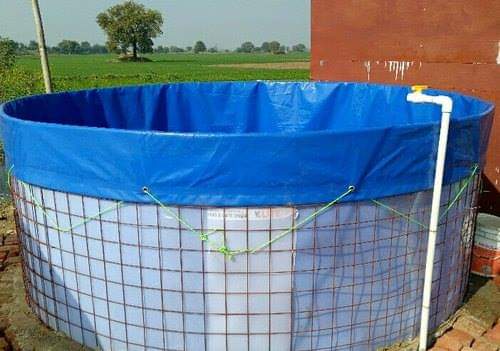Why Biofloc Fish Farming is becoming popular Day by Day as Startup among unemployed Educated Youth during COVID19 Period?
Biofloc Fish Farming is a new technology that enables intensive fish/shrimp production in a limited area, without upping the consumption of basic natural resources such as land or water. Several varieties of fish, such as GIFT Tilapia, Magur, Pangasius, Anabas, Common Carp, can be reaped through this method.
In Biofloc technology, the waste organic matter in the tank, such as feed waste, is digested using probiotics (helpful bacteria) and a carbon source such as molasses and gets converted to fish feed. This also reduces the expenditure on overheads for the cultivator. Generally, each biofloc tank is filled with an estimated 1,000-1,500 numbers of quality fish (2-3 cm), and a production target of 500 kg of fish is set for a six-month span.
This Profitable Method of Fish Farming or Biofloc Farming cuts all the major costs so that the savings can be really big. Several factors such as Huge operational costs, cost of vast lands, high costs of feeding, disposal and discharge of waste sludge will not be problems when your opt for this method.
In Aquaculture, the major cost is due to feeding ingredients for fishes. When fishes are fed with high protein diets, approximately 70% of it is discharged as waste in surrounding culture water in the form of nitrogen. With biofloc, we can recycle this waste into feed again reducing the expense of high protein feeds. Biofloc systems also reduces the spread of pathogens while also improving the fish health.
By cutting all these costs, you, yourself can assess that it will easily double your income by increasing quantity of fishes while not compromising on quantity.
Biofloc is an eco-friendly fish farming technology. Biofloc technology offers benefits in improving aquaculture production that could contribute to the achievement of sustainable development goals. This technology can be an innovative strategy for disesase control and prevention such as antibiotics, antifungal, probiotics & prebiotics application and also could result in higher productivity with less impact on the environment. Furthermore, biofloc system may be developed and performed in integration with other food production. This technology has the obvious advantage of minimizing water requirement and organic matter and it turns improving farm biosecurity by exclusion of pathogens, augmentation of natural food and improvement of FCR, providing a stress-free environment. The biofloc technology is still in its infant stage. A lot more research is needed to optimize the system e.g. in relation to nutrient recycling, MAMP production and immunological effects. Biofloc technologies have the potential to revolutionise the aquaculture system.
WHY BIOFLOC TECHNOLOGY (BFT)?
Low investment of Approximately Rs. 30000-40000/- only for the installation of 4M dia tank depending location and labour cost
Production of 600 kgs of Biomass can be achieved within 5 months of proper culture technology.
Return on Investment (ROI) is within one harvest.
Suitable for India Tropical conditions as well as
In Temperate condition can be cultured through environmental manipulation
Almost all types of fishes can be cultured.
Food fish, as well as Ornamental fishes, can be cultured in biofloc systems
The environmental friendly aquaculture system
Efficient alternative system to traditional aquaculture system
No wastage as nutrients are continuously recycled and reused
Sustainable system
Minimum or zero water exchange
microorganisms (biofloc) has two major roles:
*Maintain water quality
*Act as food for fish and provide nutrition
Reduces FCR (Feed Conversion ration)
Decreases Feed Cost
Increases Vertical production
Minimum water discharge and reuse of water prevent eutrophication or organic pollution
Ecofriendly or green approach technology
Minimum exchange of water retain heat and avoid temperature fluctuations
BFT is also called as
ZEAH or Zero Exchange Autotrophic Heterotrophic System/Active-sludge or suspended bacterial-based system
Single-cell protein production system/
Suspended-growth systems/
Microbial floc systems
Biofloc mass is also referred to as Biofloc Meal
Here are few elnisted advantages for Biofloc aquaculture.
Advantages Of biofloc culture system
1.Bio-floc act as a substitute for fish meal in aquaculture feed.
2.The protein level in bio-floc ranges from 15% to 20 %.
3.Bio-floc system provides a protective shell to the fish, through a probiotic effect(Depression of Tilapia infection by Streptococcusbacterial problem).
4.Reduced need for water exchange.
5.Higher stocking densities of fishes.
Biosecurity can be maintained.
6.Better feed utilization & reduced FCR.
7.Better nutrition by continuous consumption of bio-floc.
8.Enhance growth performance and survival.
9.Maintain favourable water quality and enhanced production.
10.Reduction in feed cost.
11.Reduction in toxic metabolites.
12.Reduction in stress.
13.Reduction in the pathogen.
14.Production (Carrying capacity): 5% to 10% better than the normal system.
15.FCR low – between 0.6 to 1.0.
16.Production cost is lower by around 15% -20 %.
Disadvantages of biofloc system
1.Reduced response time because water respiration rates are elevated.
2.Start-up period required.
3.Alkalinity supplementation required.
4.Increased pollution potential from nitrate accumulation.
5.Inconsistent and seasonal performance for systems exposed to sunlight.

Prashant Kumar,CEO-Riya Enterprises,Ranchi


